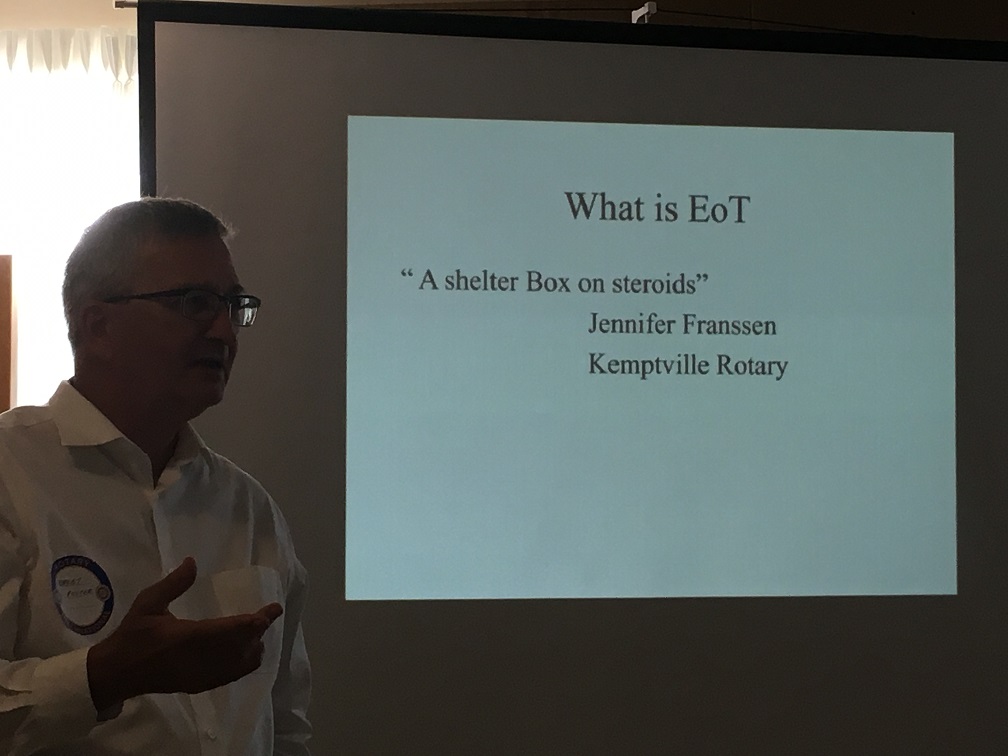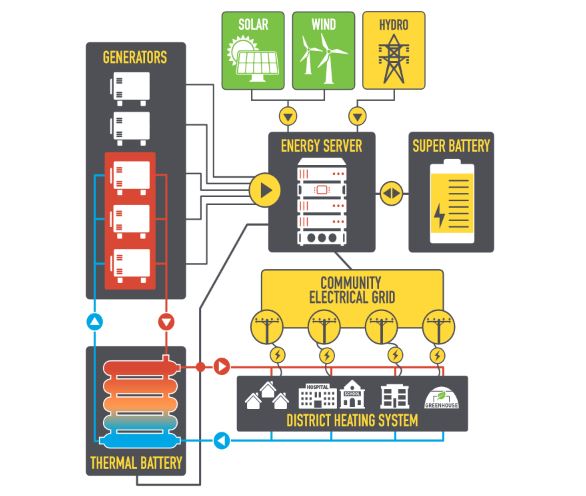Robert Reid introduced speaker Birket Foster from Chesterville Rotary to speak about the EOT (Emergency Operation Things) Project. Birket spoke at the District Conference last year and President Ana felt it was important for him to connect with us, because of our involvement in Indigenous projects through our National Committee.
EOT really started from Birket organizing his high school reunions for Beaconsfield High School. A legacy idea emerged that might change people’s lives. Chesterville Rotary Club was already involved with Ryan’s Wells, helping dig wells in Africa, and someone said "why not do the same work here in Canada?"

The problem in Northern communities isn’t just getting clean water - the need is also for enough pumpable water to put out fires. Last summer, two fire-fighting schools were set up, at two levels. This was the initiative of Connie Delisle, a person with indigenous background and experience with the Privy Council, as well as a public safety background. Jennifer Franssen from Kemptville Rotary got involved, as well as a couple of members from DART (disaster assistance recovery team) with their technology that provides potable water at the site of any disaster as soon as they get there.and a modified Shelter Box with stoves and water kits was created. All of these Rotary connections are bringing all the assets needed together - water, sewage treatment, power, and communications.
The talk was full of examples of key aspects of the project being facilitated by making connections with people with specific expertise and experience; e.g., need for sewage, power, communications. Whenever he talks about the work to Rotarians, some speaks up with expertise and ideas to share.
So the Four Avenues of Service of this project are: water, waste water, power, communications
Key features that will guide the project are;
- community discussion on the project - finding communities that want to do this. Birket intends to connect with HIP (Honouring Indigenous Peoples) to help find communities that are interested because this is a collaboration between Rotary and the community. The community will get Federal Government funds.
- examine deployment model, ensuring community involvement, to ensure sustainability; needs to start with proper assessment. This opens the Infrastructure Bank to get funds. Joseph Redhead from the West Ottawa Rotary, a retired water engineer got involved at this point to help guide the assessment.
- look at level of implementation, connecting with existing infrastructure, use a 'lego block' strategy to make things scalable.
- define the “topup” including integration with existing infrastructure to open up the funds
- decide on deployment (materials, training—who and what). Eight people will be trained in the four categories and will need to be paid a stipend for their work. Training is critical - a $26 million water project now sits idle in a Northern community because training was not addressed properly.
- time for delivering, installing, training, then commissioning, operating, and monitoring are all keys aspects
- the goal is to find a community with a problem, not the worst water problem, to test the concept and tweak things that can be done better
- add to list of resilient communities
This is summarized in the flowchart below (apologies for any problems viewing the chart)

36 of our District 7040 clubs have said they want to help
The overall philosophy is: accuracy first, then momentum. We need to understand community needs to get the ball rolling. The target is next year to launch.
Q: What about provision of (electrical) power?
A: Varies according to equipment. Need enough to run whatever equipment you have. In B.C., Jennifer stashed generators throughout province to ensure earthquake readiness.
Example of new company using banks of small generators, serviceable locally, with heat recovery, heat battery, and energy server, etc. This resulted in huge change in Fort Providence, B.C., actually taking the town off the grid. The system stabilizes the community electrical system. A greenhouse is producing fresh vegetables year-round.
The model looks like this;

see ssie.ca for details (Innovative Energy Solutions for Remote Communities)
Questions and Comments
Greg Mumford: An observation. Started with a discussion with the community. So much hinges on their wanting it, wanting to drive it. What are the criteria for working with communities?
A: Yes. This is for the north.
Onagotay: Nothing for the people without the people. If you don’t gather the people, what they want and need, it won’t work.
Ed Thompson: Through my experience working in the 1980's, the big problem is in sustainability. Where does funding for that come?
A: There are funds available for training.
John Richards: Cost of assessment
A: $80,000 approximately
John Farrow thanked Birket with the traditional loaf of bread.

